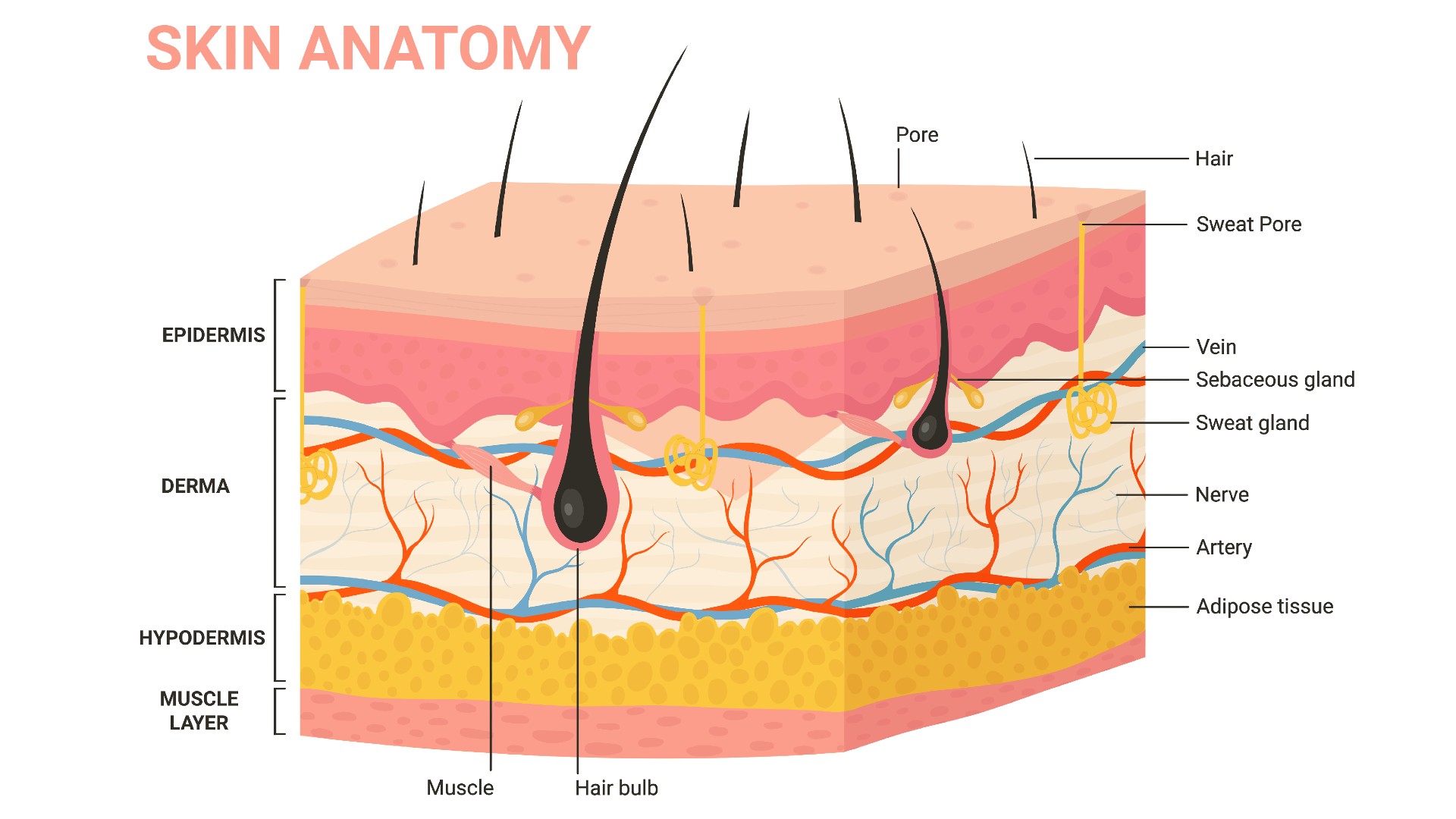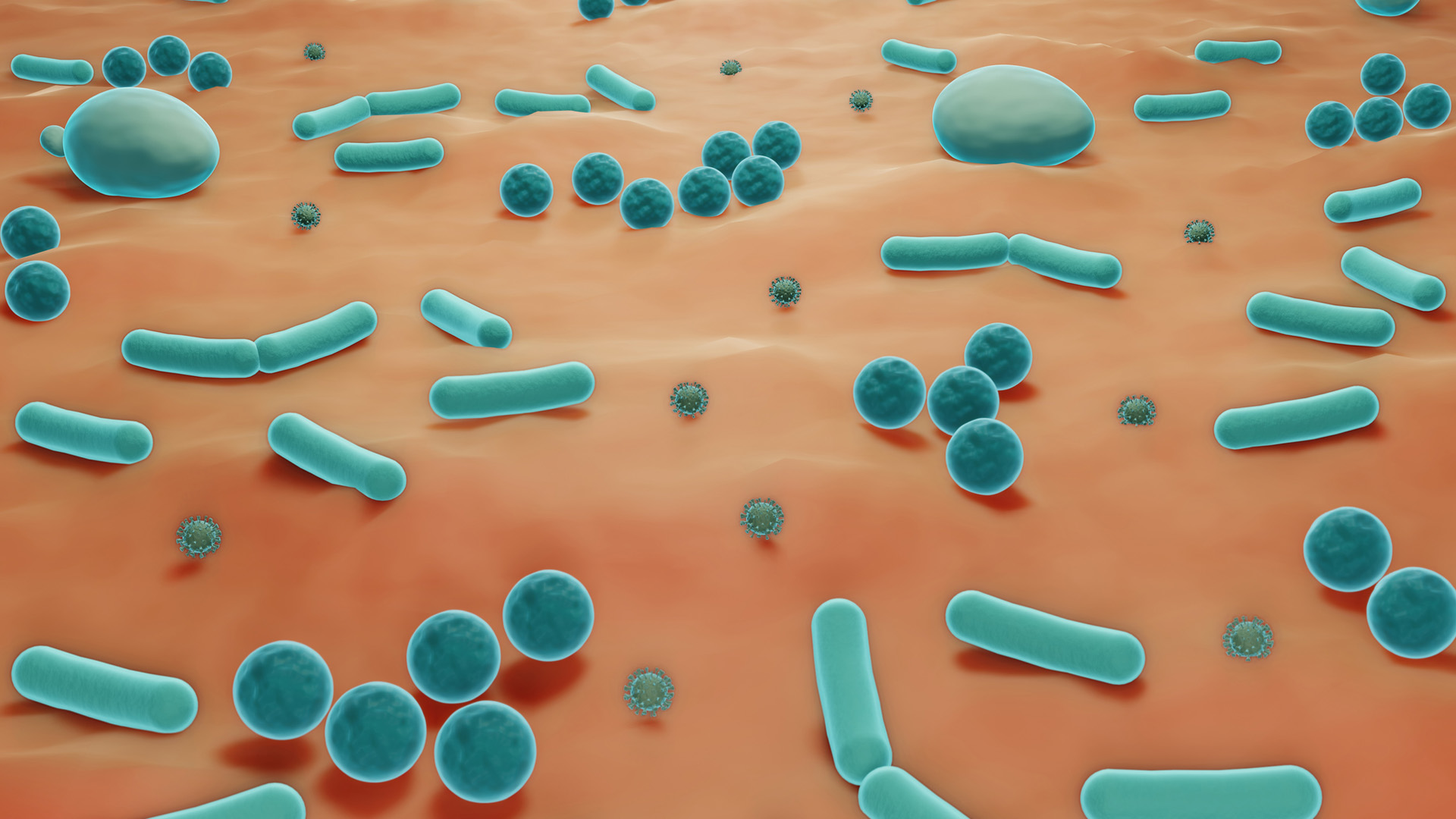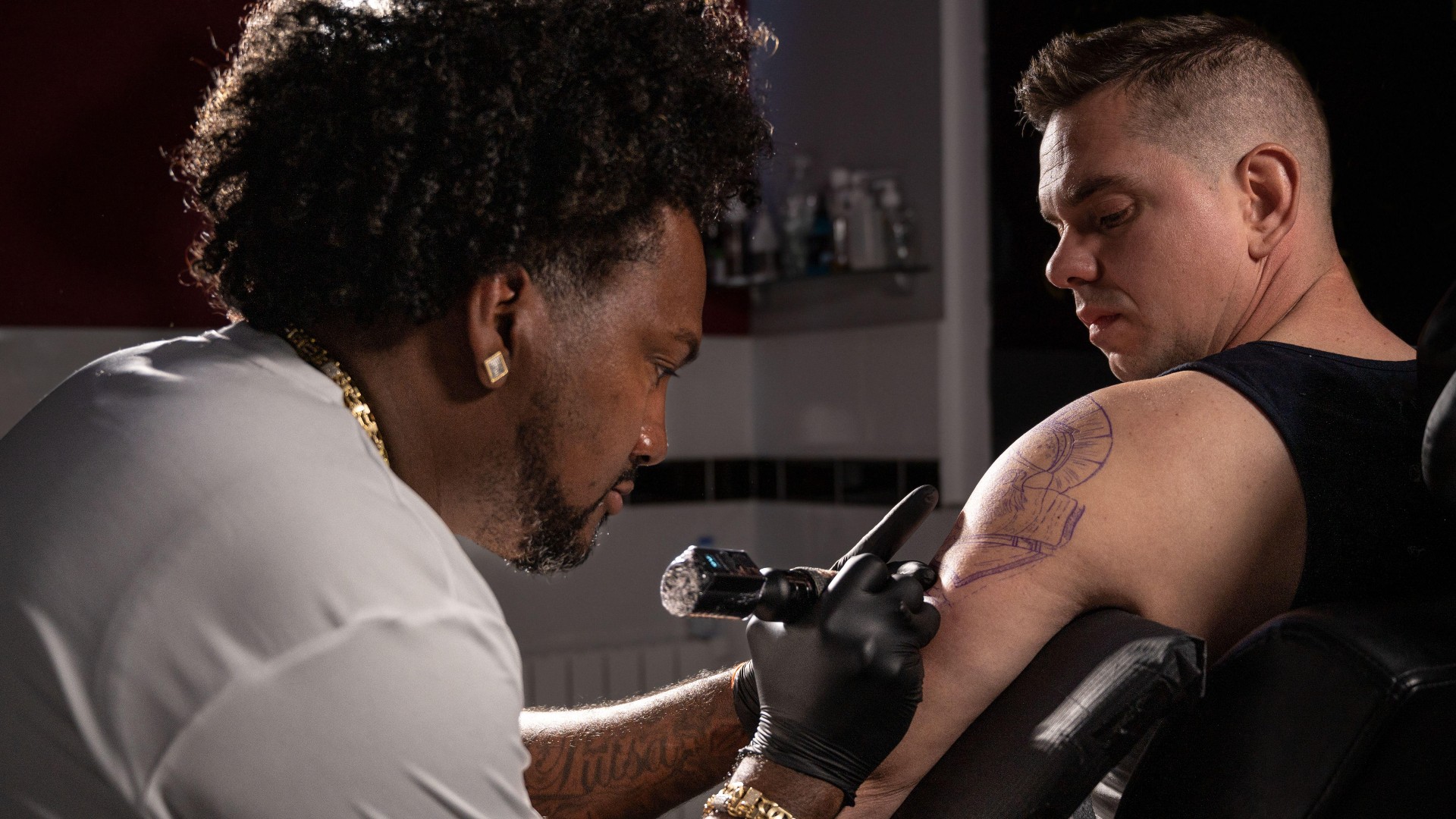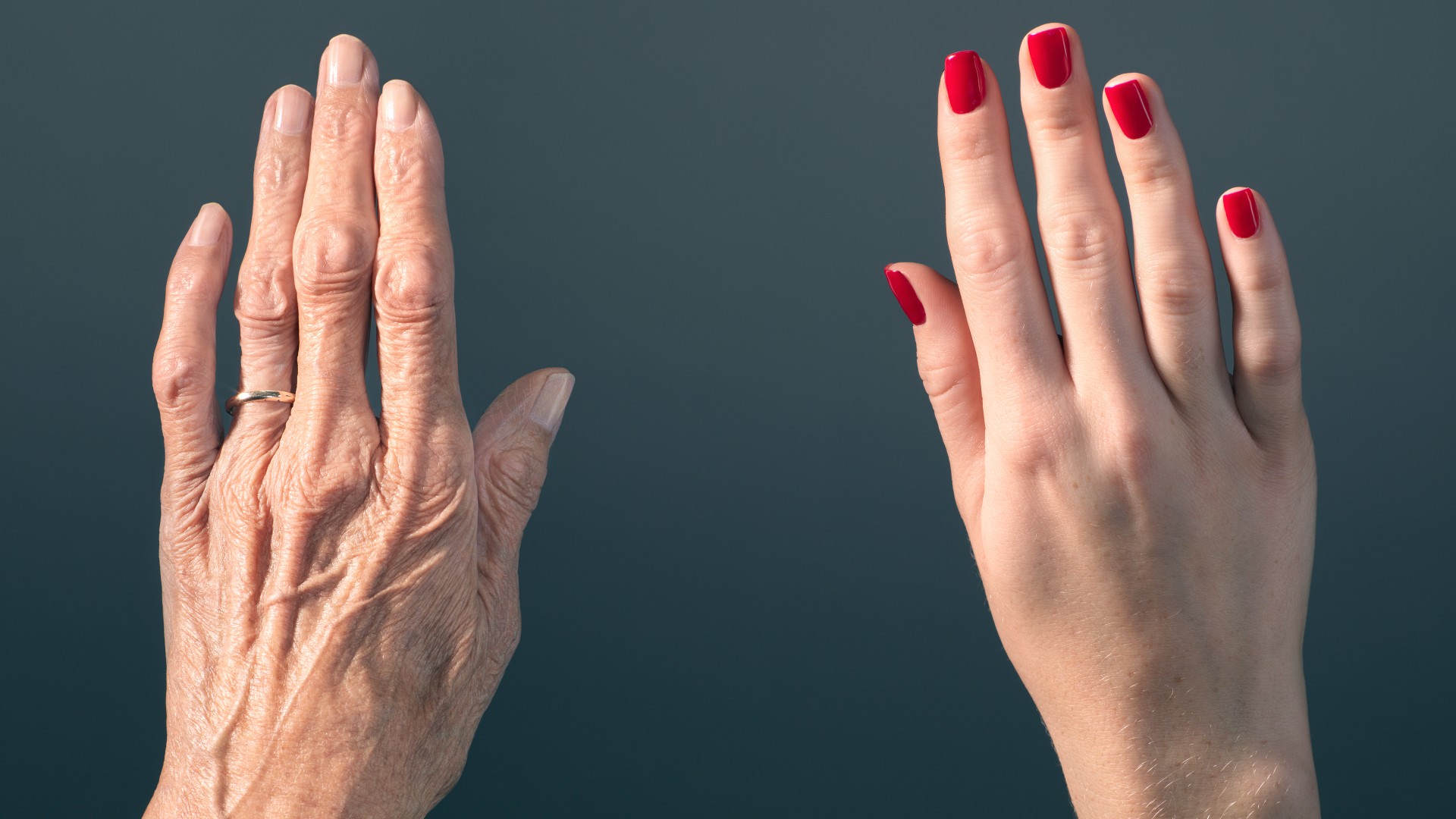Skin: Facts about the body's largest organ and its functions
The skin is the body's largest organ and performs many vital functions.

Skin is the body's largest organ and, along with hair, nails, and skin-associated nerves and glands, is part of the integumentary system, according to the medical resource StatPearls.
This system acts as a protective barrier between the external environment and the inside of the body, shielding the internal organs against heat, light, injury and infection. In addition, skin plays an important role in regulating body temperature, preventing water loss, producing vitamin D and detecting sensations caused by mechanical stimuli that make contact with or put pressure on the skin.
In an average adult, skin accounts for about 15% of total body weight and covers a surface area of approximately 22 square feet (2 square meters), according to the Institute for Quality and Efficiency in Health Care. That said, some scientists include fewer layers of tissue in this estimate and suggest that the average adult's skin accounts for closer to 6% of their overall body weight.
There are different thicknesses and textures of skin on different parts of the body. For example, skin is thicker on the soles of the feet and palms of the hands, and thinner on the eyelids and genitals, StatPearls states.
How many layers does skin have?
Human skin is composed of three layers of tissue: the epidermis, dermis and hypodermis. The thickness and density of skin layers vary among individuals, depending on their age, sex and genetic factors. For example, female adults and children typically have thinner skin than male adults in most areas of the body. Environmental influences, such as exposure to sun or certain medications, may also affect skin density, according to StatPearls.
Epidermis
The epidermis is the top, visible layer of skin. It is further divided into four layers: the stratum basale, stratum spinosum, stratum granulosum and stratum corneum. The thick skin on the palms and soles of the feet has an additional layer, called the stratum lucidum, according to StatPearls.
Keratin, a protein made by cells in the epidermis, gives skin its toughness and strength, according to a 2009 review published in the Journal of Anatomy. The epidermis is constantly renewed as dead skin cells are shed daily. New skin cells form at the bottom of the epidermis. As these newer cells form, it takes them about one month to reach the top layer of the epidermis. The new cells then replace the old cells on the skin's surface.
Get the world’s most fascinating discoveries delivered straight to your inbox.
The epidermis contains melanocytes, which are cells that produce melanin, the pigment that gives skin its color. Melanin is also responsible for suntans and freckles, according to StatPearls.
Dermis
The dermis is the middle layer of skin, found underneath the epidermis. It is further divided into two layers: the papillary dermis (the upper layer) and the reticular dermis (the lower layer). The dermis is the thickest layer of skin and contains nerves and blood vessels. It is also home to the sweat glands, oil glands and hair follicles. The dermis is made up mostly of a protein called collagen that makes skin stretchy and strong, according to StatPearls .
Hypodermis
The hypodermis, also called subcutaneous fat, is the deepest layer of skin. This layer is made up mostly of fatty tissue, which helps to insulate the body from heat and cold; cushion internal organs, muscle and bones; and protect the body from injuries, according to StatPearls.
What is the function of the skin?
Skin functions as a protective barrier against harmful microbes, mechanical injury, heat and hazardous substances that could otherwise damage the body's internal tissues. It also plays other important roles in the body, including the following:
- Sensing pain and touch: Nerve endings in the dermis contain receptors that react to specific stimuli and trigger signals that get sent to the brain, where they're interpreted as various sensations, such as pain, pressure, touch, itchiness and temperature.
- Producing sweat and oils: Sweat glands help to cool the body, and sebaceous glands make the oils that keep skin soft and moist.
- Growing hair: Hair follicles found in the dermis grow the hair on your head, face and body. That hair also helps to control body temperature and protect the body from injury.
- Bringing blood to the skin: Blood vessels found in the dermis nourish the skin and help control body temperature. When skin becomes too hot, blood vessels widen to release heat from the skin's surface, while cold constricts blood vessels so they retain body heat.
- Fighting infection: Lymphatic vessels, which drain fluid from the tissues and are an important part of the immune system, are housed in the dermis. They help ward off infections and harmful substances.
- Producing vitamin D: Exposure to sunlight triggers the production of vitamin D in the skin.
Is skin waterproof?
Skin is waterproof due to the anatomical makeup of the upper and lower layers of skin. It is a functioning organ that is constantly healing and remodeling, which helps maintain the skin's integrity, Dr. Ross Perry, aesthetic doctor and medical director at Cosmedics Skin Clinics in England, told Live Science.
Keratin is one of the main components of the skin's waterproof barrier, according to StatPearls. Because this protein cannot dissolve in water — meaning it's "water insoluble" — it seals the skin barrier and prevents water from breaking through. Sebum, which is also water insoluble, coats the surface of the skin, protecting it from drying out.
The organization of fats in the superficial layers of the skin may also contribute to its waterproof properties, according to a 2012 study in the Journal of Investigative Dermatology. The study authors looked at samples of skin scrapings and found fatty structures "that had not previously been described in a biological system." They not only appear to make skin resistant to water but also enable the skin to bend, the study authors noted.
What is the skin microbiome?
The skin microbiome refers to microorganisms, such as bacteria and fungi, that live on the surface of the skin. These microbes are found mostly on the superficial layers of skin and hair follicles. Helpful microbes found in the skin microbiome play an important role in protecting the skin from harmful microbes that might overgrow on the skin and cause infection, Perry told Live Science.
Many microbes on the skin can produce molecules that prevent the colonization of other microorganisms or alter their behavior to make them less threatening to the host. In addition, some bacteria, such as Staphylococcus epidermidis, have been found to bolster resilience to infections by prompting the host's immune system to produce more messenger proteins essential to fighting inflammation, according to a 2018 review published in the journal Nature Reviews Microbiology.
The skin microbiome of a healthy adult stays relatively stable over time, but the composition, or balance, of microbes may differ depending on the skin site. For example, species in the genera Staphylococcus and Corynebacterium tend to be found in moist areas, including on the feet and the bends of the elbows. Species in the genus Propionibacterium, on the other hand, are more abundant on the skin sites that are richer in sebaceous glands, such as the scalp, the review authors noted.
Why does skin tan?
Tanning is the skin's response to ultraviolet (UV) radiation. When skin is exposed to UV rays, it produces more melanin pigments. Melanin is the first line of defense against sun — it absorbs the UV rays and prevents them from damaging the skin. When the amount of UV light exceeds the amount of protection melanin can provide, the radiation may lead to sunburn, premature skin aging, cataracts and even cancers, according to Johns Hopkins Medicine.
People have different levels of sensitivity to UV rays, depending on their age, health status and skin type. Adults over age 50, children under 5, people with light complexions and those with immune system deficiencies tend to be more at risk of harmful effects of tanning, according to the Food and Drug Administration (FDA).
"Although people with darker complexions are less likely to get skin cancer than people with lighter complexions, they can still develop malignancies and suffer all forms of UV damage," the FDA notes.
How do tattoos stay on the skin?
Tattoos are made permanent by puncturing the skin and implanting ink down into several layers of the skin dermis, Lucy Phillips, dermatology nurse and managing director of Kaizen Medical in England, told Live Science by email.
Once the ink is planted in the skin, it is taken up and stored by macrophages, a type of immune cell. When these cells die, they release the ink and pass it on to other macrophages. This way, the tattoos do not "stain" the skin cells, and they are not perceived as a danger by the immune system defenses, according to a 2018 study in the Journal of Experimental Medicine.
As a general rule, tattoos are safe if done in a proper establishment, with clean instruments and high-quality ink. However, some people who get tattoos experience complications. For example, they may develop skin infections such as cellulitis, an infection that affects the skin's deepest layers, Phillips said. (Cellulitis is not to be confused with cellulite, which is when fat in the skin bulges through an overlying web of connective tissue, creating a dimpled appearance.)
Although tattoos are deemed permanent, they can be removed by various treatments, including surgery, chemical peels, and lasers that emit high energies that destroy tattoo ink, according to a 2017 review in the American Journal of Clinical Dermatology. The type of laser used depends on the patient's skin color, as some lasers remove melanin and melanin-producing cells called melanocytes from the skin, along with the ink-filled macrophages. Moreover, some tattoo ink colors are not totally removable, particularly turquoise, yellow and red, Phillips said.
Why does skin age?
With age, skin becomes thinner, less flexible and more prone to wrinkles, dryness and age spots, also known as liver spots. Bumps, cuts and other wounds also may take longer to heal, while small blood vessels may be more visible through skin, according to the National Institute on Aging. Aged skin is characterized by a decreased number of skin cells and a breakdown of the skin's structural proteins, such as collagen. Compared with young skin, aged skin also has higher levels of inflammation and skin-damaging free radicals, reactive molecules produced as a byproduct of metabolism, according to a 2021 review in the International Journal of Molecular Sciences.
Skin aging may be categorized as "intrinsic" or "extrinsic," depending on the factors that are driving the process, according to a 2021 systematic review and meta-analysis published in the journal Scientific Reports. Intrinsic aging is directly related to a person's age and genetic makeup, while extrinsic aging is influenced by environmental factors, such as air pollution, nutrition, smoking and excessive tanning, the review authors noted.
Diseases of the skin
Many conditions can affect the appearance, integrity or functionality of the skin. While some are relatively harmless, some diseases, such as skin cancer, can be life-threatening. In a related article, Live Science discusses 10 common skin conditions and their effects on the body.
This article is for informational purposes only and is not meant to offer medical advice.

Anna Gora is a health writer at Live Science, having previously worked across Coach, Fit&Well, T3, TechRadar and Tom's Guide. She is a certified personal trainer, nutritionist and health coach with nearly 10 years of professional experience. Anna holds a Bachelor's degree in Nutrition from the Warsaw University of Life Sciences, a Master’s degree in Nutrition, Physical Activity & Public Health from the University of Bristol, as well as various health coaching certificates. She is passionate about empowering people to live a healthy lifestyle and promoting the benefits of a plant-based diet.
- Kim Ann ZimmermannLive Science Contributor
 Live Science Plus
Live Science Plus











